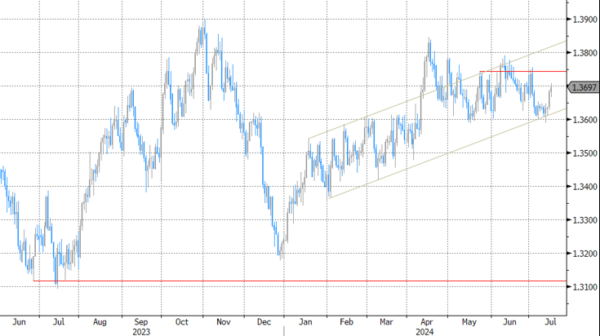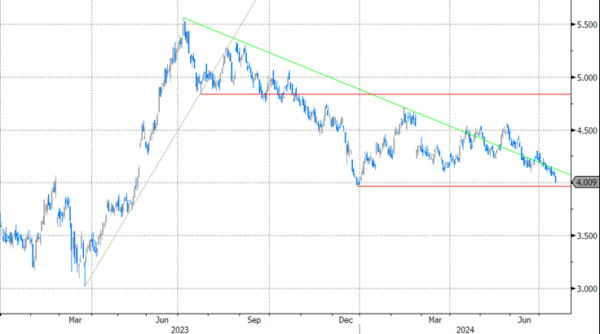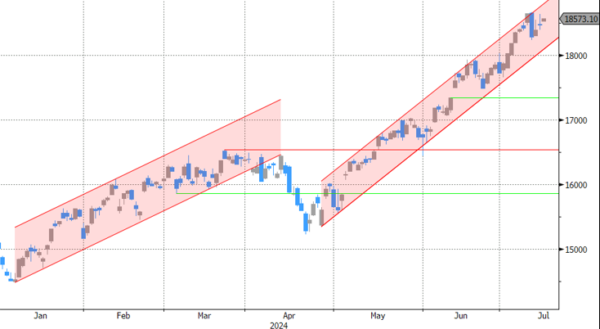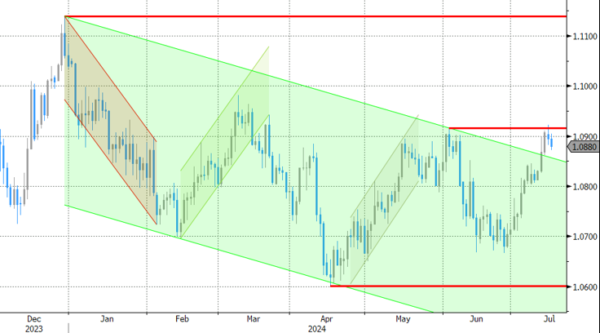Markets
Global core bonds gained some ground going into today’s main dish, US retail sales. UK gilts slightly outperformed Bunds and Treasuries as markets gear for tomorrow’s June CPI numbers. A further easing on all accounts is expected but the sub 2% drop in the headline reading, if it were to materialize, will probably grab most of the headlines as paving the way for a first Bank of England cut in August. Money markets give it a 50% probability currently and have a total of 50 bps cut priced in for all of 2024. Front end yields slipped the most (up to 7 bps) with the UK 2-yr yield testing the 4% reference for the first time this year. German and US yields eased between 5 and 6.5 bps across the curve with the latter undoing part of yesterday’s “Trump steepening”. Focus in Europe went to the ECB’s quarterly lending survey (down below). Currency markets barely budged.
Enter retail sales. June turnover after an upwardly revised May came on the much stronger side of expectations with the headline number being flat compared to the estimated 0.3% m/m decline. Core gauges ranged from +0.4% for the series excluding autos (vs +0.1% expected) to +0.9% for the control group (ex. food, gas, building materials and car dealers, +0.2% expected). The latter is used in the calculation of private consumption for GDP. Sales rose in most categories but two components acted as a strong drag. Motor vehicles & parts tanked 2% m/m while gasoline stations’ sales dropped no less than 3%. Today’s data snaps a streak of below-consensus outcomes that included US ISM’s, payrolls and CPI. But even as the front of the US curve erased all previous gains, money market expectations for the Fed changed little. Yields at longer maturities pared losses to 4 bps. The dollar in printing its biggest intraday move strengthened against the euro to EUR/USD 1.0874. USD/JPY edged towards 158.73 and cable (GBP/USD) eased further from the highest level in a year around 1.30.
In news after the US retail sales, the IMF in an update to its World Economic Outlook raised 2024 growth forecasts for China (5%), India (7%) and marginally for the euro area (0.9%) while slightly adjusting the US (2.6%) downwards. Projections for most major economies in 2025 were left unchanged with China (+0.4 ppt to 4.5%) being a noticeable exception. The IMF also issued a warning on inflation. It said that stubborn wage-driven service prices are hampering the disinflation process, creating upside risks and the prospect of “higher-for-even-longer interest rates”. New forecasts show global inflation is unlikely to return to 2% until the end of next year.
News & Views
The ECB quarterly bank lending survey (BLS) showed a very small further tightening of credit standards for loans or credit lines to corporates in Q2 (net percentage of banks of 3%). Banks’ risk tolerance was the main driver. They expect a further moderate tightening in Q3 2024 (5%). Firms’ net demand for loans declined further (-7%), although by substantially less than in Q1 (-28%). Banks expect a first net increase in demand for loans since Q3 2022 in the next quarter. Credit standards for loans to households for house purchases showed a moderate further net easing (-6%; mainly because of competition) while those for consumer credit pointed to a moderate further net tightening (+6%; driven by risk perceptions). Banks expect credit standards to remain broadly unchanged in both loan categories in Q3 2024. Net demand for both housing loans and consumer credit increased for the first time since 2022 (respectively +16%, improving housing market prospects & +13%, spending on durables and consumer confidence). A further improvement is expected for Q3, especially for housing loans.
Canadian headline inflation fell by 0.1% on a monthly basis in June, coming off a 0.6% M/M increase in May and beating +0.1% M/M consensus. Main downward contributors were travel tours, gasoline, clothing and passenger vehicle prices. Core inflation (ex food and energy) was flat on the month. CPI rose 2.7% Y/Y, down from 2.9% in May, matching the slowest pace since March 2021, largely the result of a slower rise in gasoline prices. Lower prices for durable goods (-1.8% Y/Y) also contributed. The Bank of Canada’s preferred core gauges (median & trimmed mean) respectively slowed from 2.7% Y/Y to 2.6% and stabilized at 2.9% Y/Y. Canadian sovereign bond yields follow today’s global move down with the belly of the curve outperforming (-5 bps). The Loonie loses out against a stronger dollar with USD/CAD reclaiming 1.37. Today’s inflation print and yesterday’s BoC business outlook suggest that the Bank of Canada could cut its policy rate a second time at next week’s policy meeting.
Graphs
USD/CAD tests 1.37 big figure after CPI miss paves the way for a second BoC rate cut next week
UK 2-yr yield flirts with 4% barrier for the first time this year going into tomorrow’s (<2%?!) CPI release
Nasdaq nicely developing within the upward trend. Last week Thursday’s slip-up all but erased
EUR/USD: failed test of 1.09 yesterday meets with follow-through return action in wake of consensus-topping retail sales

















